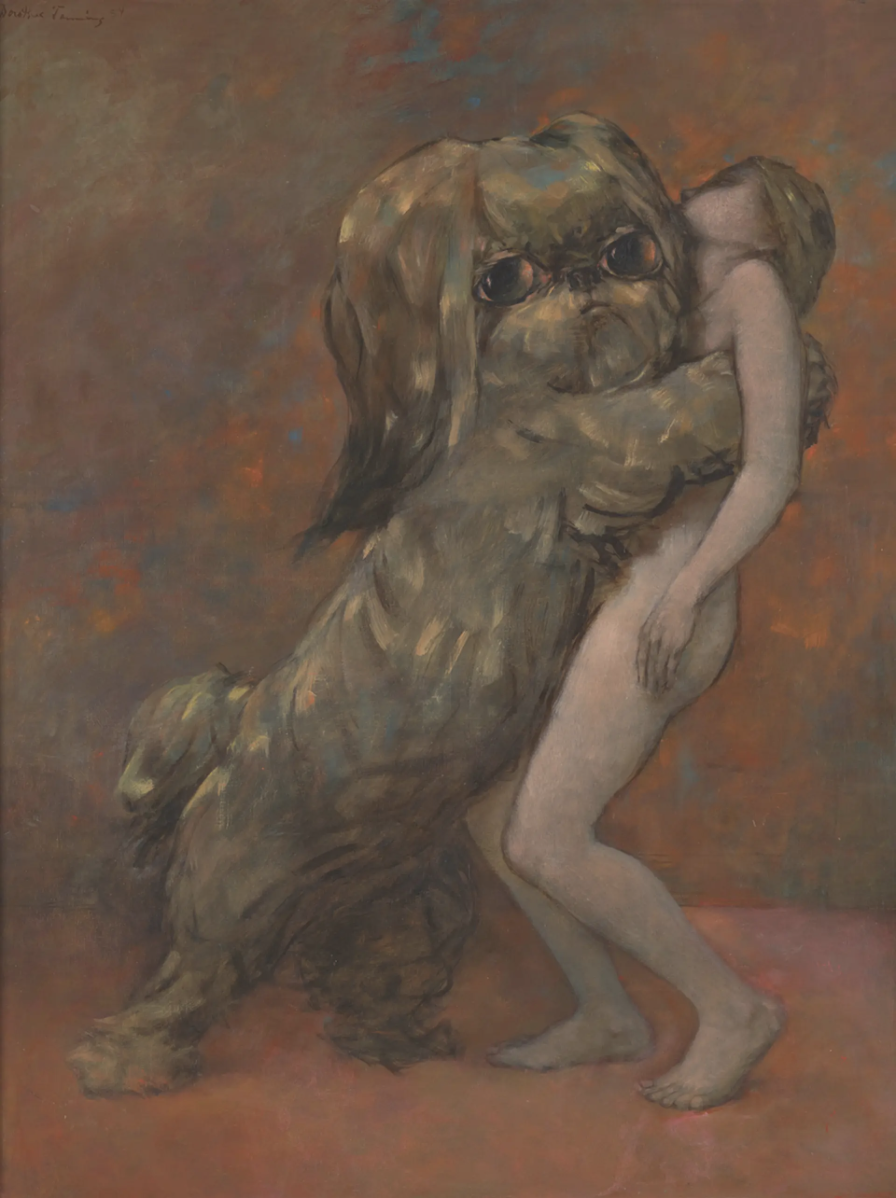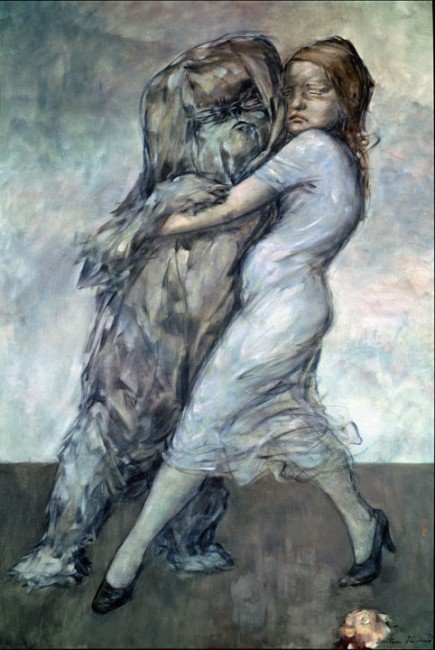‘Magic in this Dog’ – Artistic Incarnations of Dorothea Tanning’s Katchina
By Nicole Entin
In Peter Schamoni’s 1978 short film, Insomnia: The Paintings of Dorothea Tanning, the American Surrealist artist speaks about her beloved pet dog, Katchina, who she shared with her husband Max Ernst: ‘I had a dog once whose ancestors lived in the Tibetan monasteries […] I convinced myself that the dog knew the great questions and even some of the answers. I could make myself see magic in this dog. Its face began to appear in my pictures and looked so right, that pretty soon it was hard to make a picture without it.’
Dorothea Tanning, Tableau Vivant, 1954, oil on canvas, 45.75 x 35 in, Scottish National Gallery of Modern Art Edinburgh
I first encountered Katchina in Edinburgh, in the ‘New Arrivals’ exhibition at Modern One. In a room that also housed one of Dali’s iconic Lobster Telephones (1938), Chagall’s dreamy L’Écuyère (1949-53), and the towering blue hawk of Toyen’s The Message of the Forest (1936), I came face to face with a Lhasa Apso terrier with unnervingly human eyes that stared out from the picture plane, holding a limp, nude woman in its furry paws. Tableau Vivant (1954) was one of Dorothea Tanning’s favourite works, albeit one that she was reluctant to define and interpret for critics.
Dozens of questions abound when looking at this Surrealist interpretation of the relationships between animals and humans. Is Katchina’s embrace protective or possessive? Who or what is the woman held by Katchina supposed to represent? Does the work encourage or evade biographical readings?
From the 1950s and onward, Tanning’s beloved dogs became a continuously recurring motif in her oeuvre, appearing in oil paintings, watercolours, sketches, collages, and even in gold jewellery. Katchina originally belonged to Max Ernst’s ex-wife, the art patron and collector Peggy Guggenheim, who agreed that Ernst could keep the dog after their divorce in exchange for adopting two of Katchina’s puppies.
Dorothea Tanning, Max Ernst and Katchina, date unknown, photograph.
Named after the carved figures made by the Hopi people of Arizona, which are given to young girls as instructive representations of the nature spirits that inhabit the world, Katchina appears frequently in the works of both Ernst and Tanning. While between the two artists Ernst was more well-known for his other Surrealist animal alter-ego, Loplop – a mystical bird who often acted as a meta-narratorial figure within Ernst’s paintings – Tanning more frequently identifies herself with Katchina, as exemplified in The Artist as a Dog (1967).
Dorothea Tanning, The Artist as a Dog, 1967, photographic collage, 7.75 x 10.5 in, Dorothea Tanning Foundation, New York.
In this photographic collage, Katchina’s head, taken from Tanning’s painting Katchina and her Soul (1961), is attached to the artist’s body as she holds a dog in her arms, the chaise on which she reclines surrounded by a furry rug. The image is both a representation of the unity which derives from animal companionship, as well as the expression of a greater universal connection between the human and natural worlds. The darkness of the canine eyes, obscured behind fur, are almost unnerving in their directionless yet infinite gaze, suggesting the perception of realities beyond our own.
Tanning’s paintings featuring Katchina and motifs of dogs embody the Surrealist fascination with dreams, alternative states of consciousness, and the anti-rational. As well as being an alter-ego for Tanning, Katchina was more generally ‘a state of mind’ through which the artist could explore the nature of appearances, alternate visions of the natural world, and uncanny re-evaluations of the familiar. Discussing Tableau Vivant in a 1977 interview with Tanning, Marcel Duhamel suggests that Tanning’s depiction of Katchina is rather unsettling in its apparent ‘psychoanalysis’ of the dog, which appears to project human feeling and desire onto Katchina. Duhamel’s commentary touches on one potential interpretation of the uncanny anthropomorphism in Tanning’s works featuring canine imagery, including Tableau Vivantas well as The Blue Waltz (also of 1954).
Dorothea Tanning, The Blue Waltz, 1954, oil on canvas, 51.02 x 38.02 in, Dorothea Tanning Foundation, New York.
In The Blue Waltz, Katchina appears waltzing with a clothed female figure physically reminiscent of the female nude in Tableau Vivant. The shared melancholic expressions of Katchina and the woman in the painting suggest an intriguing empathy between human and animal in grief, as they cling onto each other in the movements of the dance. While Duhamel’s interpretation is tinged with a critical undertone, Tanning herself humorously rejects the notion of psychoanalysing her pets: ‘my dogs are loathe to be psychoanalysed. If I gave a Katchina a human dimension, it is because I see her that way, that is to say that I decided to see her that way.’
Dorothea Tanning, Katchina and Her Soul, 1961, oil on canvas, 24 x 8 in, Dorothea Tanning Foundation, New York
Tanning’s emphasis on her ‘decision’ to see Katchina with a human dimension is an intriguing endorsement of conscious processes in the creation of her art, rather than the interest in subconscious and unconscious creativity – free association, neurosis, the ‘pure psychic automatism’ of André Bréton – which characterised Surrealist art in its earliest form. Tanning’s works featuring Katchina straddle this incongruity between conscious and unconscious processes of art-making. Elements of automatism are evident in the abstract metamorphic form which occupies the top right of the canvas in Katchina and Her Soul, exemplifying Tanning’s visualisation of something as transient as the concept of a soul.
Dorothea Tanning, Les Trois Garces, 1953, oil on canvas, 45.63 x 20.88 in, Dorothea Tanning Foundation, New York.
At the same time, Katchina’s image is used to purposeful satirical effect in Les Trois Garces (1953), which reimagines the Three Graces – the embodiments of classical beauty as depicted by artists from Botticelli to Canova – as chimeric dog-human hybrids. Their heads, torsos, and legs are that of furry terriers, but between the waist and the knees, they are human nudes. Tanning evokes a variety of concepts surrounding feminine sexuality in the punning title of the painting, swapping two letters to transform Les Trois Grâces (The Three Graces) into Les Trois Garces (The Three Bitches). In doing so, Tanning visually mocks the way in which women and animals are conflated by the male gaze, as well as the derogatory language that dehumanises women, and additionally challenges a traditional image of ideal feminine beauty.
Dorothea Tanning uses the recurring motif of Katchina in her art to interrogate a variety of concepts about affinities between humans and animals. By making works that present women and animals side by side, or even coexisting within one body, Tanning creates dream-like images that present Katchina as transcending both reality and fixed identity. Inhabiting a number of forms, roles, and symbolic meanings, the bond between Tanning and Katchina serves as an agent of artistic creativity and innovation.
Notes:
Duhamel, Marcel. Dorothea Tanning: Numéro Spécial de XXe Siècle. Paris: Editions XXe Siècle, 1977, pp. 110-111.
National Galleries Scotland. ‘Dorothea Tanning: Tableau Vivant’, 2019. https://www.nationalgalleries.org/art-and-artists/178474#related-media-anchor.
Phillips Auctioneers. ‘Max Ernst: Kachina, le chien de Peggy Guggenheim’, 2021. https://www.phillips.com/detail/max-ernst/NY010721/45
Schamoni, Peter, director. Insomnia: The Paintings of Dorothea Tanning. 1978; Argos Films, Paris and Munich. 15 min.






